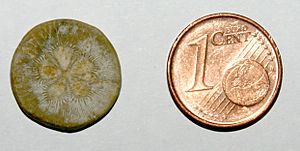Tessera (commerce) facts for kids
A tessera was like a special token or ticket used in Ancient Rome. These small pieces, often made of clay, bone, or bronze, had different uses. The most common ones were for getting into events or for receiving food and money from the government.
What Was a Tessera?
A tessera was a small, flat piece of material, often shaped like a square or rectangle. The word "tessera" comes from a Greek word meaning "four-sided." Romans used these tokens for many things, but they are best known for two main purposes: as tickets for public events and as tokens for government handouts.
Tickets for Roman Shows
One important use for a tessera was as a ticket to enter large public events, like gladiator fights or chariot races. Imagine going to a huge stadium like the Colosseum in Rome. Your tessera would have numbers stamped on it. These numbers told you which entrance aisle to use and which row to sit in. It was a very organized system for managing large crowds! The numbers above the doors of the Colosseum matched the numbers on these tickets.
Tokens for Food and Money
The Roman government sometimes gave out special tesserae to its citizens. These were called tesserae frumentariae (for grain or food) and tesserae nummariae (for money). Roman leaders, known as magistrates, would give these tokens to people. In exchange for a tessera, a citizen could receive a set amount of wheat (grain) or a certain amount of money. This system helped the government distribute resources to the people.
See also
 In Spanish: Tésera para niños
In Spanish: Tésera para niños



